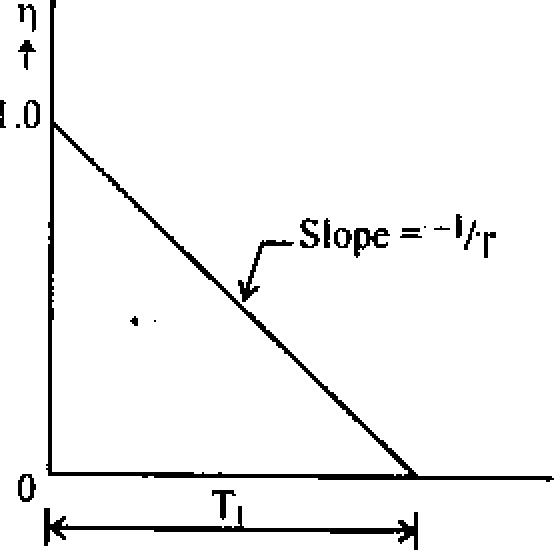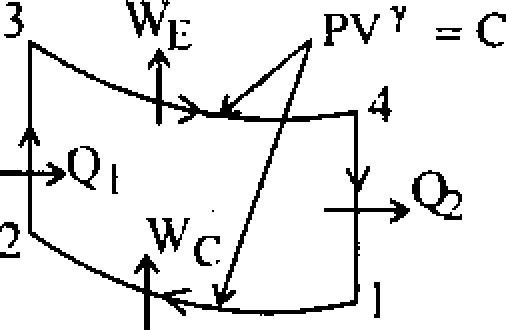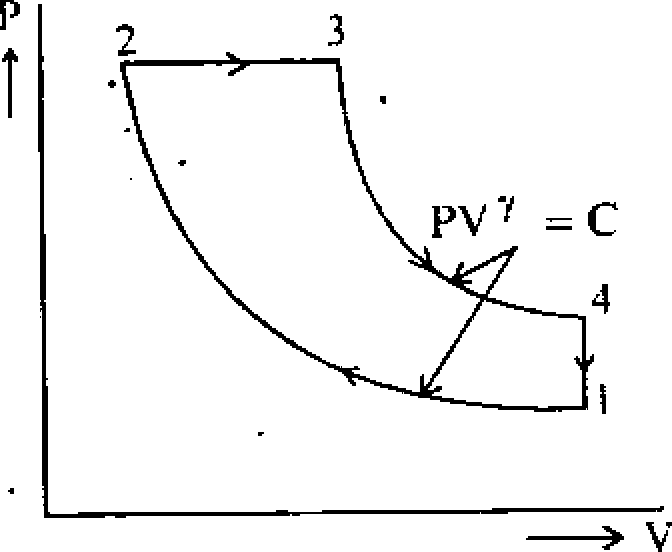West Bengal Institute of Technology (WBIT) 2008-2nd Sem B.Tech Computer Science and Engineering Computer Science - Thermodynamics & Fluid Mechanics(solved) - Question Paper
Wednesday, 17 July 2013 06:10Web
Page 1 of 2
MECHANICAL SCIENCE2008
SEMESTER-2
Time: 3 Hours / Full Marks: 70
GROUP-A (Multiple Choice Type Questions)
1. Choose the correct alternatives for the foHowing : 10x1=10
(i) Which of the following is an Intensive thermodynamic property?
(a) Volume (b) Temperature (c) Mass (d) Energy.
(ii) For an Irreversible process, change in entropy is .
(a) greater than dQ/T (b) less than dQ/T (c) zero (d) equal to dQ/T.
(iii) During throttling, which of the following quantity does not change ?
(a) Internal energy (b) Entropy (c) Pressure (d) Enthalpy.
(iv) Work done in a free expansion is
(v) A cycle with constant volume heat addition and constant volume heat rejection is (a) Otto cycle (b) Diesel cycle (c) Joule cycle (d) Rankine cycle.
(vi) Triple point of a pure substance is a point at which
(a) liquid and vapour coexist (b) solid and vapour coexist
(c) solid and liquid coexist r (d) all three phases coexist. ,
(vii) Bernoullis equation deals with the conservation of
(a)Mass (b)Momentum (c) Energy (d)Work.
(viii) Continuity equation is based on the principle of conservation of
(a) Mass (b) Momentum (c) Energy (d) Entropy.
(ix) A Pitot tube is used for measuring
(x) Dynamic viscosity has dimensions of
(a) MLT"2 (b) ML'V (c)ML_V2 (d) M L_' T*'
Aus. (i) b ; (ii) a; (iii) d ; (iv) c ; (v) a; (vi) d ; (vii) c, (viii) b ; (ix) a ; (x) d.
GROUP-B (Short Answer Type Questions )
Answer any three of the following. 3x5 = 15
2. State the first law of thermodynamics for a closed system undergoing a cycle and a process.
Ans. When a closed system undergoes any cyclic process, the cyclic integral of work is proportional to the cyclic integral of heat.
5w - <j)5w ,
The first law of thermodynamics for a process is 8Q = dE + 8w Where 5Q - heat Supplied dE _ internal energy 5w - work done
3. Explain thermodynamic equilibrium.
Ans. A System is said to existin a state of thermodynamic equilibrium when no change in any macroscopic property is registered, if the system is isolated from its surroundings. A system will be in a state of thermodynamic equilibrium, if the conditions for the following three types of equilibrium are satisfied.
(a) Mechanical equilibrium
(b) Chemical equilibrium .
(c) Thermal equilibrium ; .
In the absence of any unbalanced force within, the system itself and also between the system and the surroundings, the system is said to be in a state of mechanical equilibrium.
If there is no Chemical reaction or transfer of matter from one part of the system to another, such as diffusion or solution, the system is said to exist in a state of chemical equilibrium.
When a System existing in mechanical and chemical equilibrium is separated from its surroundings by a diathermic wall and if there is no spontaneous change in any property of the system, the system is said to exist in a State of thermal equilibrium.
4. The fluid flow is given by v = x2yi + y2zj - ( 2 xyz+yz2) Show that this is a case of possible steady incompressible flow. Calculate the velocity and acceleration at ( 2,1,3 ).
v = x2yi+y2zj-2xyz+yz2 Jk For the given fluid flow field
u -x2y = 2xy .
dx
i dv _ .
v = ylz = 2yz
dy '
w = -2xyz-yz2
dz
For a case of possible steady incompressible fluid flow, the continuity equation should be
dudvdw .
satisfied, i.e.T_ + 'T_+ "
ok oy dz .
5u 3v 5w
Substituting the values of, - and -r~ we get .
ox oy dz -
<?u dv dw *
Sx + dy + ~dz = 2xy + 2yz ~~ 2x/ = 0 a
Hence the velocity field V = x2yi + y2zj - (2xyz + yz2) k
is a possible case of fluid flow. .
velocity at (2,1,3) .
Substituting the values x = 2, y = 1 and z = 3 in velocity field, we get
V = x2yi. + y2zj - (2xyz + yz2) 1c
= -22 x 1 f + 12 x 3 j-(2x 2 *1x3 + 1 x 32)lc .
A A A
V = 4 i + 3 j 21 k .
and resultant velocity = 42 +32 +(-21)2 = V466 = 21.587 units The acceleration components ax, ay and a2 for Steady flow are.
|
ax |
= u |
t+v |
cu
ay |
+ w |
|
ay |
= u |
S+v |
dx
Sy |
+ wf |
|
az |
= u |
S-+V |
dw
5y |
+ w |
|
|
|
du |
|
dVL |
|
u =: |
*2y, |
5x |
!2xy,= By |
5ii
and = 0 dz
du dv dv , .
V">'2z-S*0>=2yz&=3' .
_ 5w . , 5w w = -2xyz-yz2, ~-~2yz, 2xz-z - =--2xy-2yz J J dx 5y dz ' /
Substituting these values, in acceleration components, we get acceleration at ( 2,1,3)
ax=x2y(2xy) + y2z(x2)-(2xyz + yz2)(0) .
= 2x3 y2 + x2 y2 z ,
= 2x23xl2 + 22 x \2 x 3 = 28 units ay = x2y (0) + y2z (2yz) - (2xyz + yz2) (y2)
= 2y3 z2 - 2xy3z - y3z2 .
= 2 x 13 x 32 2 x 2 x 13 x3l3 x 32 = 3 units .
az = x2y (_2yz) + y2z (-2xz - z2) - (2xyz + yz2) (-2xy -2yz)
= - 2x2y2z - 2xy2z2 - y2z3 + [4x2y2z + 2xy2z2 + 4xy2z2 + 2y2z3]
= _2x22x 12x3_2x2x l2 x 32 + [4 x22 x 12x.3 + 2x2x 12x42 + 4x2
' x l2 x 32 +2 x ]2 x 33]
az=I05 _
A A /I A
acceleration = ax i + ay j + azk = 28 i - 3 j + 105 k
|
Resultant acceleration = 282 +(-3)2 + 1052 = Vl 1818 = 108.71 units.
5. Draw a block diagram of vapour compression refrigeration cycle and also show the cor- |
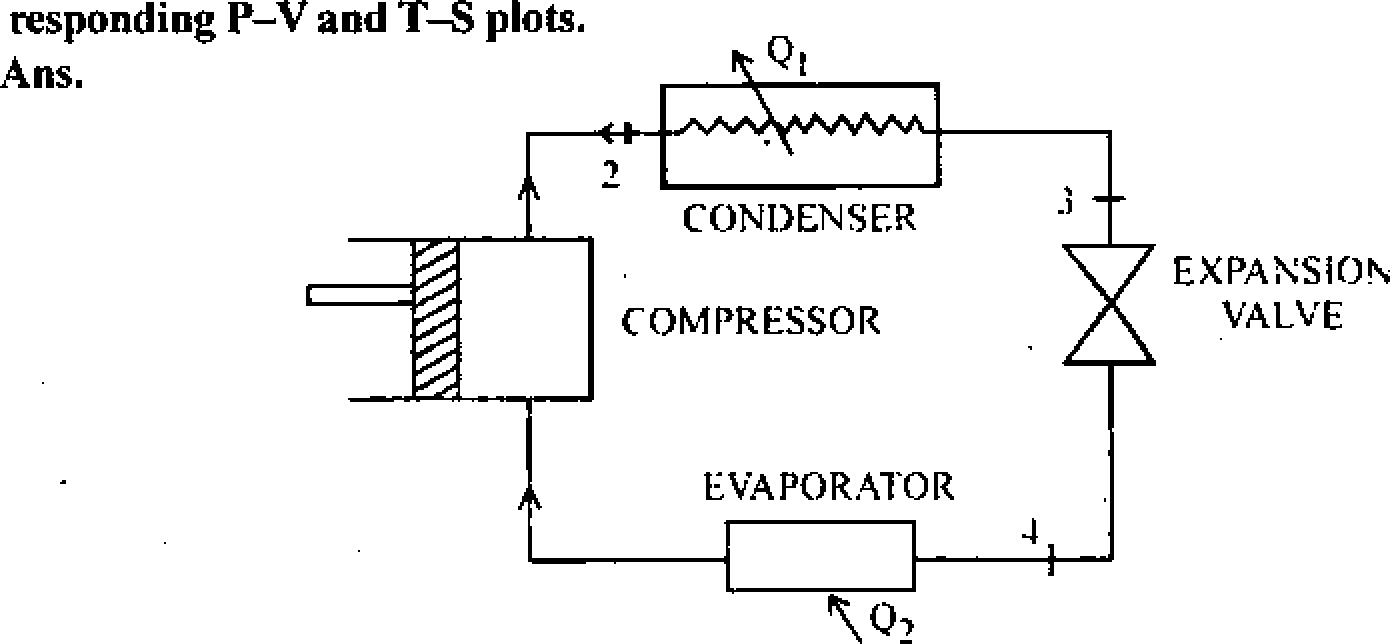 |
|
Block diagram of a vapour compression refrigeration cycle |
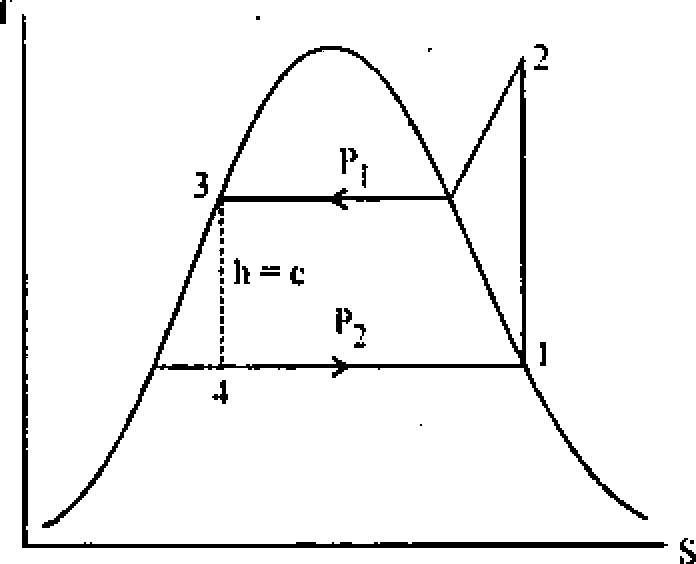 |
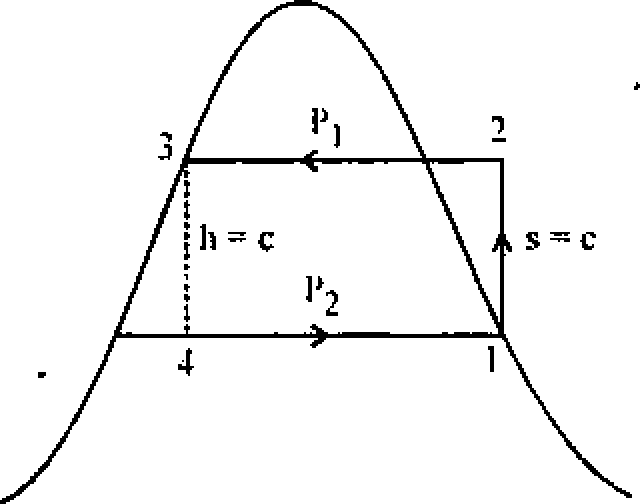
6. Derive. Bernoullis equation form first principles, stating the assumptions.
Ans. Lei us consider a stream line in which flow takes place along the s-direction as shown in the figure. Let us consider a cylindrical element of this streamline having cross section dA and length ds. The forces acting on the cylindrical element are-
(i) Pressure force pdA in the direction of flow.
dp '
(ii) Pressure force
P + ds dA opposite to the direction of flow, s
(iii) Weight of the element pg dA ds.
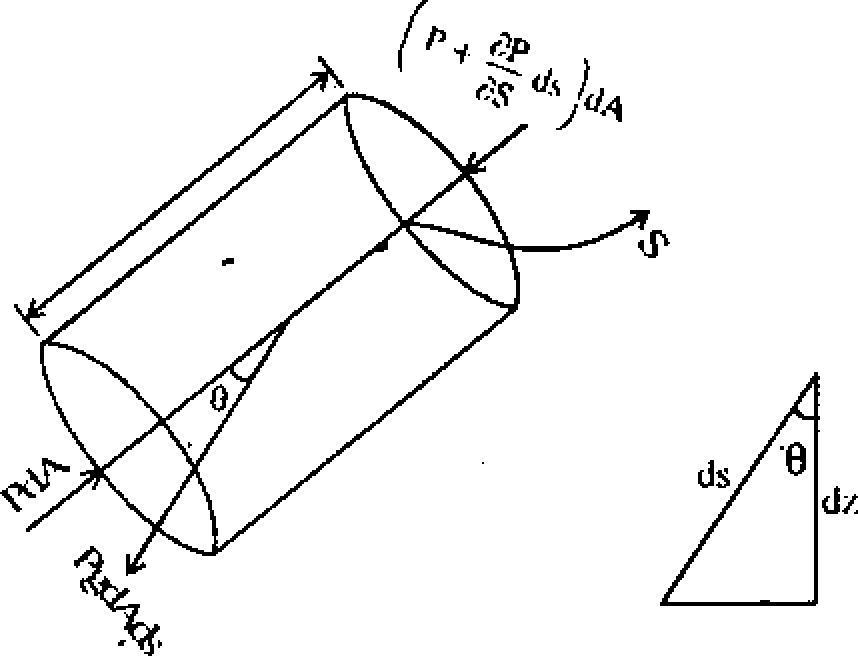
The resultant force on the fluid element in the direction of S must be equal to mass of the fluid element * acceleration in the direction. .
d A -pgd Ads cos0 = pd Ads x as
where as is the acceleration in the direction of S dv
vi u , ds, v dv Svf ds 1
Now a, = , where v is a tunction ofS and t = + = v + Ty T = v r dt ds dt dt os dt I dt J
dv
If the flow is steady, - = 0 pt
Substituting the value of as in equation and simplifying the equation, we get.
- ds dA - pgd A ds cos0 = pd A ds x v
cs 3s
Dividingby pdsdA ----gcos0 = or-- + gcose + - = 0 pSs 5s pds ds
ori!L + gdz + . = o Ucos0 = l
pds ds 5s L dsj
6p
or - + gdz + vdv = 0
P .
t
which is known is Eulers equation of motion. If p is constant i.e. for in compressible fluid, integrating Eulers equation we get, ,
P v P v -
*- + gz + = constant or + - + z = constant p 2 pg 2g _
Which is Bemoullis equation
The assumptions mdde for the above derivation '
(i) Fluid is ideal i.e viscosity is zero
(ii) Flow is steady t -
(iii) Flow is incompressible
(iv) Flow is irrotational
7. Explain PMM-1 and PMM-2.
Ans. PMM1: A mechanical device, which, once set in motion, would continue to run for ever, is known as PMM 1. From the first law of thermodynamics, we know that energy transforms from one form to another. It cannot create its own energy out of nothing. So PMM 1 violates the first law and cannot exist.
PMM2 : It is perpetual motion machine of the second kind which produces net work in a cycle by exchanging heat with only one thermal energy reservoir and thus violates the kelvin Planck Statement. -
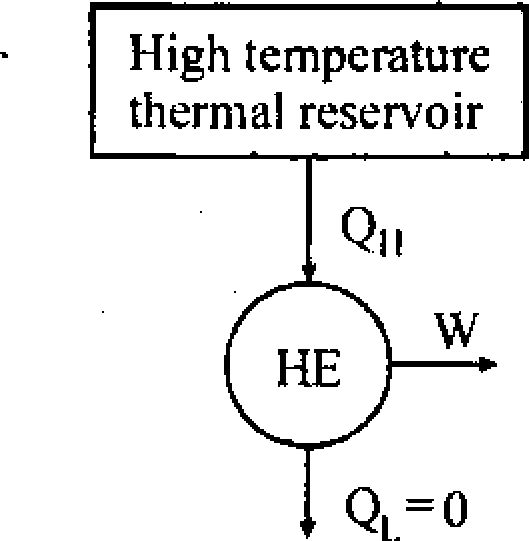
GROUP-C (Long Answer Type Questions)
Answer any three of the following. 3 X 15 = 45
8. (a) Which is a more effective way of increasing the efficiency of a Carnot engine to increase source tcmperatue (T|), keeping sink temperature (T2) constant or to decrease T2 keeping T| constant.
Ans. The efficiency of a Carnot engine is given by
n = i--
If T2 is constant
/
an 1 _ t2
v3tJT2 t(2
* . fill As Ti increases,.r| increases and the slope
s. If T. is constant,
remains constant.
dr] =_
JT1 t,
As T2 increases, r| increases, but the slope
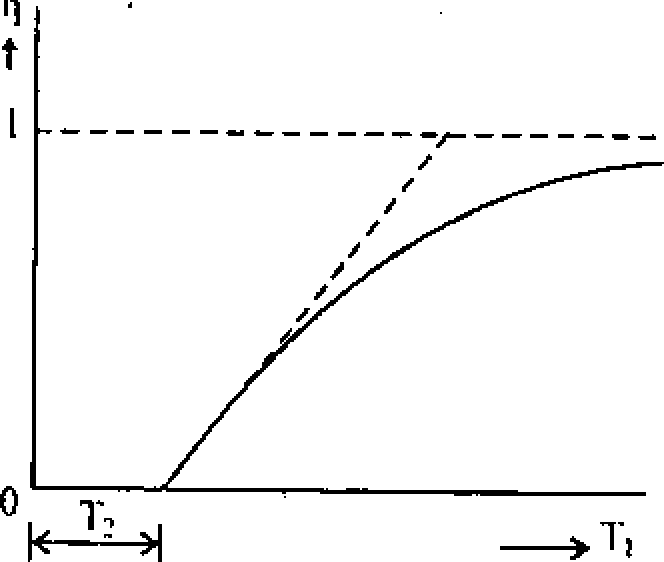
dr) ST,
So the more effective way to increase the efficiency is to decreaseT2
(b) State Clausius inequality. '
Ans. Clausius inequality states that when a system undergoes a cyclic process, the cyclic integral
of v I always less than zero for an irreversible cycle and is equ<o zero for a reversible cycle.
Temperature T in the clausius inequality refers to the temperature of the thermal reservoir and not of the system.
(c) A mass of m kg of liquid (specific heat = Cp) at a temperature Tj is mixed with an equal mass of the same liquid at a temperature T2 ( T| > Tj ) and the system is
thermally insulated. Show that the entropy change of the universe is given by 2m Cp
( nn A
T + T Ar *2
and prove that this is necessarily positive. 3+2+10
Ans. Let Tf be the final temperature after mixing mcp (T1 - Tf) - mcp (Tf- T2)
or T( = + 12
' 2 . : ,
. Tf
The change of entropy of hot hiquid = me p /n
. ' * , Tf - .
The change of entropy of cold liquid = mcpin~
*2
T T .
Net entropy change = mcp Inf + mCp In-f-. .
M - 12 .
, Tf . , Tf ip- - . T,+T2
= me. In = 2mc_ In rd = 2mc In , 1 = 2mcn In rJ
. p T|T2 p Jffo p
j + j _
and T,T2 are the arithmetic and geometric mean of Tj and T2 respectively. As we
. t1+t; ..
know that arithmetic mean is greater than that of the geometric mean, therefore _ is greater
than T,T2
T.+T,
ln-
2A/T,T2 s 8reater an zero Net entropy change is positive.
(a) Derive the expression for efficiency of an Otto cyclc and show the process on p-V and T-s planes. ' *
Ans,
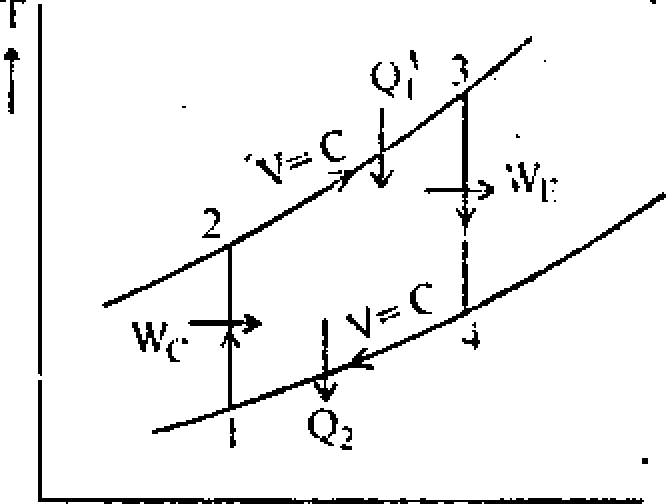 |
|
-> S |
Heat Supplied Q, = Q2_3 = mcv(T3 -T2)
Heat rejected Q2 =Q4_, =mcv(Tj -T,)
,-i Q2-1 ".(W.) Tj-T, EfTicicncy 1 Q] mc-T,)-1 x-T,
T2 v,
I -2 = ' T, i_v2
|
/ \T-< |
1 1 |
V |
|
1
> |
1a |
or - |
|
T2 |
Il=Il
T, T4
Where rj. is called the compression ratio. '
(b) For the same compression ratio, explain why the efficiency of Oito cyclc Is greater than that of Diesel cycle.
rJ-S
1 1 c_
Ans. diesel 1 y_|
V rJ /c i
Where rk is the compression ratio, rc is the cut - off ratio
1
'kT->
is also greater than unity
Therefore the efficiency of the diesel cycle is less than that of the otto cycle for the same compression ratio.
(c) In a diesel engine the compression ratio is 13 :1 and fuel is cut off at 8% of the stroke. Find the air standard efficiency of the engine. Take y for air = 1.4. S+3+2+5
rk = = 13 v2
v3 ~v2 = 0.08(v[ - v2) = 0.08(13v2 - v2) = 0.96 v2 V3 = 1.96 v2 '
r =11 = 1.96 v2
n 1 1 1 rc~1 diesi:l y rkT" rc-l
J__I (1.96)14 -1 1.4 (13)04 1.96-1
10. (a) Agas occupies 0.024 m3 at 700 kPa and 95*C. It is expanded in the non-flow process according to the law pv l>2 = constant to a pressure of 70 kPa after which it is heated at a constant pressure back to its original temperature. Sketch the process on the p-
V and T-s diagrams and calculate for the whole process the work done and the heat transferred. Take Cp =1.047 and C v = 0.775 kJ/kg K for the gas.
Ans. p(Vt12 = P2Va12
or. 700 x 0.0241-2 70 * v2'2 or, v2 = 0.1635 m3 
or T: =250.7 lk
T7 T-
rV V2T3 0.1635x368
T, 250.71
PV = m R T '
700 x 0.024 , , 72x368 [vR=CPv =1-047-0.775 = 0.272]
= 0.167 kg * .
w2-3 =p2 (v3 - v2) = 70(0.2399 - 0.1635) 5.35 KJ
Qi-2 =(2-Ui) + Ww
= mev (T2 -T| ) +w j-2 =0.167 x 0.775 (250.71 - 368) + 26.77 = 11.51 KJ 02-3 =mcv (T3-T2 ) + w2_3 =0.167 x 0.775 (368-250.71)+ 5.35 =20.529 (Ci
P
|
3 |  |
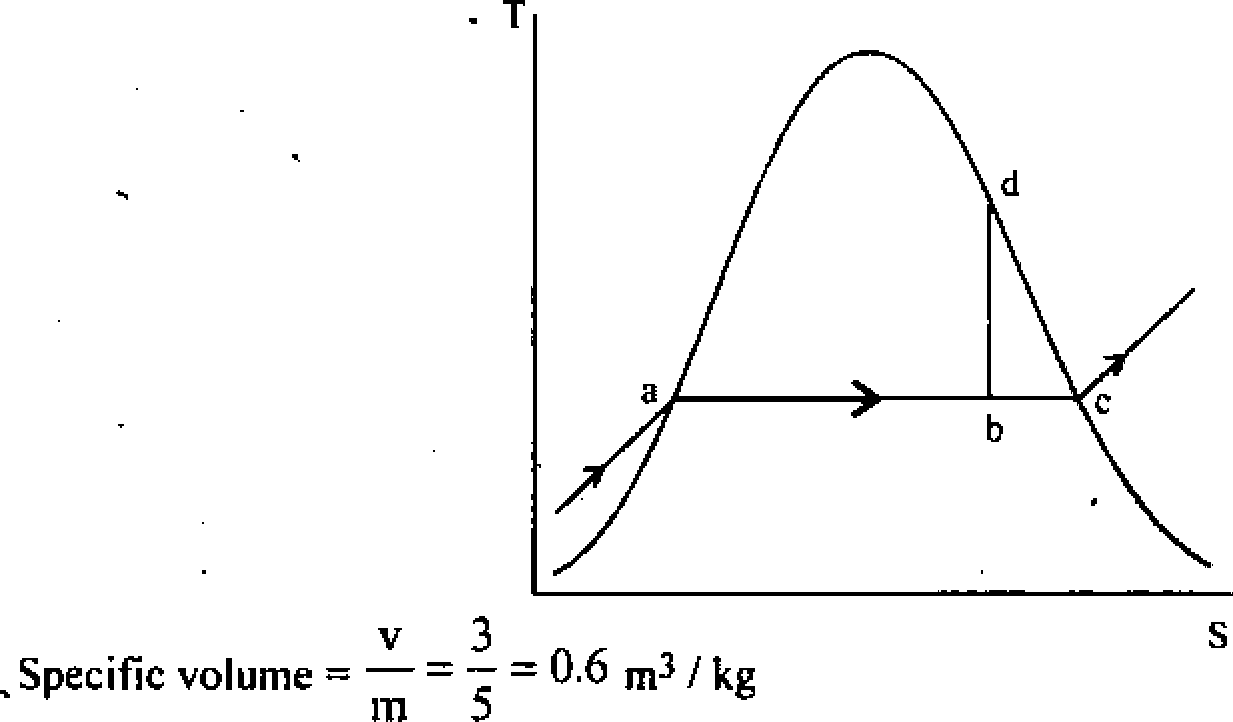
Now it is wet
v = vgx + (l x)vr or, 0.6 = 0.88540x + (1 - x) 0.001061 or, x~ 0.67727
Now since it is closed tank volume remains constant at 0.6 m3 / kg Now enthalpy at pt b is
h = hgx + (1-x) hf .
h = 0.677 x 2706.3 + (0.3227) 504.7 h = 1832.1651 - 162.8802 -h= 1995.0453
Now pressure at which the volume of the steam will be 0.6 but has io be dry saturated required.
P = 3 bar Vg = 0.60553
P = 3.1 bar Vg = 0.58718
By interpolation ,
0.60553-0.6 3.1-P 0.6-0.58718 ~ P-3
0.00553 3.1 -P or p0pg2 = pl3 or 1.43135 P- 1.29407 + 3.1 orP = 306kPa
P = 3 bar hg = 2724.7
P = 3.1 bar hg = 2726j .
By interpolation
0.60553-0.6 2726.1-hg '
0.6-0.58718 hg-2724.7 f 1-43135 = 3901 399345 or hg = 2725.67
Now ' '
Qbd =(1dub)+(p<Jvpbv) ,
Qbd =(hd-hb)+0-6(pd-pb)
Qm = (2725.67-1995.0433)+ 0.6(3.06 - 2) = 731.268 Total heat = 731.268 x 5 = 3656.34 KJ .
Ans. The pressure is 306 kPa and the heat transfer to the tank is 3656.34 KJ
The steady flow energy for a single stream entering and single stream leaving a control volume is
vf dQ v2 , dwx
"I--, >'lg-an1 - *
Where
h,, h2 are the specific enthalpy at the inlet and the outlet respectively, vj, v2 are the velocities at the inlet arid the outletrespectively.
Zj, z2 are the elevation-above an arbitrary datum at the inlet and the outlet respectively
is the heat transfer per unit mass of the fluid dm . .
dw . .
- is the work transfer per unit mass of the fluid dm ,
(b) A rigid closed tank of volume 3m3 contains 5 kg of wet steam at a pressure of 200 kPa. The tank is heated until the steam becomes dry saturated. Determine the pressure and the heat transfer to the tank. 8 + 7
Alis. At inlet to the nozzle hj = 3000 KJ/ kg = enthalpy of the flowing fluid
v, = velocity of the fluid = 60 m/s .
At the discharge end, . h2 = enthalpy = 2762 KJ / kg Since the nozzle is horizontal,
zi = z2 . .
Heat loss is negligible
(i) Hence, from the steady flow energy equation, .
' hlCh2 +Ivf!tyj =0 =>(3000 - 2762)x103=|(v?-602)
2 2 2
zr>v2 = 692.53 m / s = velocity at exit from the nozzle.
(ii) Aj = inlet area = 0.1m2
Vj = specific volume at inlet = 0.187 m3/kg 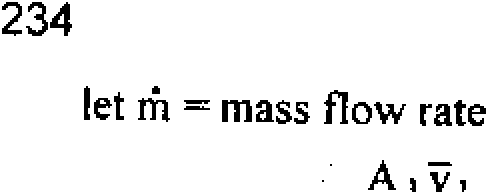
, . . i _ 0.1 x60 , *
we know, m =-- = 32.08kg/s
V! 0.187
(iii) V2 = specific volume at exit = 0.498 m3 / kg let A2 = exit area of the nozzle
A2v2 mv2 _ 32.08x0.498 " "
v2 orA2 = v2 ~ 692,53 orA2 = 2.306 * 10-2 m2 = 0.023 m2
Ans: (i) velocity at exit from the nozzle = 692.53 m / s
(ii) Mass flow rate = 32.08 kg/s
(iii) Exit area of the nozzle = 0.023 m2
12. (a) Derive Eulers equation of motion along a streamline. ,
Ans. Let us consider a streamline in which flow takes place along the s direction as shown in the figure, let us consider a cylindrical element of this streamline having cross section dA and length ds. The forces acting on the cylindrical element are
(i) Pressure force pdA in the direction of flow
(ii) Pressure force + -dsdA opposite to the direction of flow.
(iii) Weight of the element pg dAds
Let Q be the angle between the direction of flow and the line of action of the weight of the element. The resultant force on the fluid element in the direction of S must be equal to the mass of fluid element * acceleration in the direction S.
PdA - P + ds jdA - pgdAdscosO = pdAds > Where as is the acceleration in the direction of S.
Now as = where v is a function of s and t.
_ dv ds dv _ vdv dv
3s~as dt + aT"5s" at"
dv
If the flow is steady, rr U as -
di
Substituting the value of as and simplifying the equation, we get.
- dsdA - pgdA dscos0 = pdAds x
3s . os
Dividing by pdAds
-iL-geosevflv
p3s 3s
1 3P dz vdv n
or--+ g +-= 0
p 3s ds 3s
3P
or + gdz + vdv = 0 P
which is known as Eulers equation of motion.
(b) Aventurimeter has inlet and throat diameters of 300 mm and 150 mm. Water flows through it at the rate of 0.065m 3/s and the differential gauge is deflected by 1.2 m. The specific gravity of the manometric liquid is 1.6. Determine the coefficient of discharge of the venturimeter. 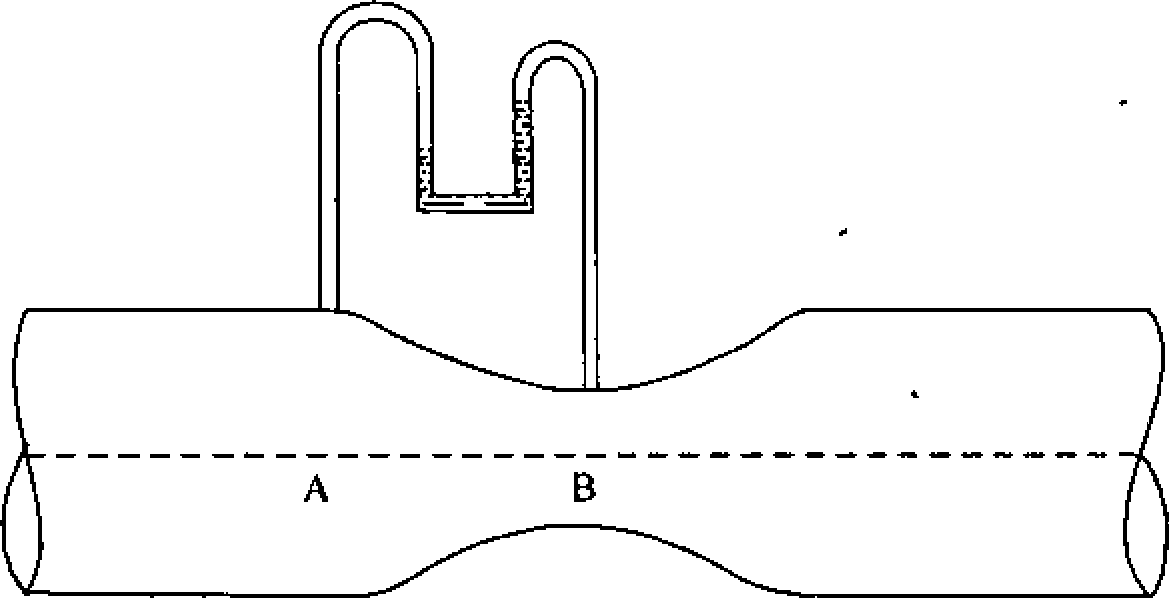
Applying Beraoulis equation between A and B and considering the fluid to be inviscid, we get
PA Va2 Pr VB
+ 0 = + 2- + 0...........' .
pg 2g pg 2g -
(the axis of the venturimeter is considered to be horizontal)
|
Solving for VB, we have
2(PA-PB)/p
)j I (Ab /A.a )'
The actual rate of discharge Q can be written as Q = CDABVB
2(PA-P B)/p = cdabJ---77...........(iv)
i_(ab / aa )
Where Q is the coefficient of discharge
From the principle of hydrostatics applied to the differential gauge, we get -(z+l)+1.6xl or PA.~-PB. = o.6m
P& pg
Hence from eq. (iv)
0.065 = C D ~ x (0.15)2 a/2x9.81x0.6/(1-1L) .
0.065x4 nin V
or CD =- -i-1-> ~~===<j.259
7t x (0.15)2 p x 9.81 x 0.6 / (1 -
(c) A Jet of water from a 25 mm diameter nozzle is directed vertically upwards. Assuming that the jet remains circular and neglecting any loss of energy, what will be the diameter of the jet at a point 4.S m above the nozzle, if the jet leaves the nozzle with a velocity of 12 m/s ? 5 + 5 + 5
Ans. Applying Bernoullis equation between (1) and (2), we get
Vt2 P2-P| V2 , e
or ---1- 0 =--1---h 4.5
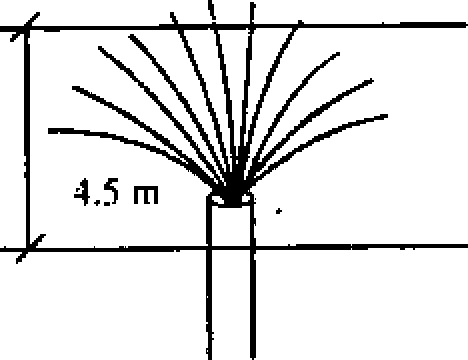 |
CD |
2 '
V, -V," -4.5mofwaterco!umn , or-!-i- =-+ 4.5
pg
v|-v,2 2 x 4.5 x IQ3 xg 2g P
or (V22-V,2) = (9x10)+4.5
or V22 = 144 + 90 + 4.5 = 238.5 or V2 = 15.44 m/s
Now from the equation of continuity '
a,v, = a2v2
orDf x 12 = -D2 x 15.44 or j(0.025)2 *12 = j * Dj x 15.44 4*4 4
or D2 = 0.022m = 22mm
13. (a) A circular disk of diameter d is slowly rotated In a liquid of viscosity u at a small distance A from a fixed surface. Derive an expression for the torque T necessary to maintain an angular velocity oa.
Ans. (a) An element of disc is considered at a radius r and having a width dr. Linear velocity at this radius = ro>.
Assuming the gap h to be small, the velocity distribution may be assumed linear Torque dT on the element,
urea . 27tuco 3, *
dT =-x27rrdrxr =-r dr
h h
Total torque T = fr3dr = -
h I 32h -
(b) Distinguish between the follow : -
i) laminar and turbulent flow
ii) compressible and incompressible fluid
iii) static pressure and stagnation pressure
iv) viscous and inviscid fluid. ;
Ans. (i) Laminar flow is defined as that type of flow in which the fluid particles move along well defined paths or stream lines and all the stream lines are straight and parallel. Thus the particles move in laminas or layers gliding smoothly over the adjacent layer. This type of flow is also called stream line flow or viscous flow. - '
Turbulent flow is that type of flow in which the fluid particles move in a zigzag way. Due to the movement of fluid particles in a zigzag way, the eddies formation takes place which are responsible for high energy loss. , .
(ii) Compressible fluid is that type of fluid whose density changes from point to point i.e. density p is not constant
Incompressible fluid is that type of fluid whose density is constant.
(iii) Static pressure - It is the pressure that would be measured by an observer or pressure sensor moving with the fluid- To such an observer, the fluid appears to be static or stationary, so this pressure is often called as static pressure. . "
Stagnation pressure - The sum of the static pressure and dynamic pressure is called the stagnation pressure. The pressure at a point in a frictionless flow where the fluid velocity is zero is known as stagnation pressure.
(iv) AH the fluids in reality which have viscosity ((J, > o) are termed as viscous fluid.
An hypothetical fluid having zero viscosity (p. = o) is called an inviscid fluid.
14. Write stlort notes on any three of the following : .
a) Pitot tube
b) Orifice meter
c) Point function and path function
d) Streamline, streaklinc and pathline.
Ans. (a) Pitot tube : It is a device used for measuring the velocity of flow at any point in a pipe or a chanet.lt is based on the principle that ifthe velocity of flow at a point becomes zero, the pressure there is increased due to conversion of the kiinetic energy into pressure energy 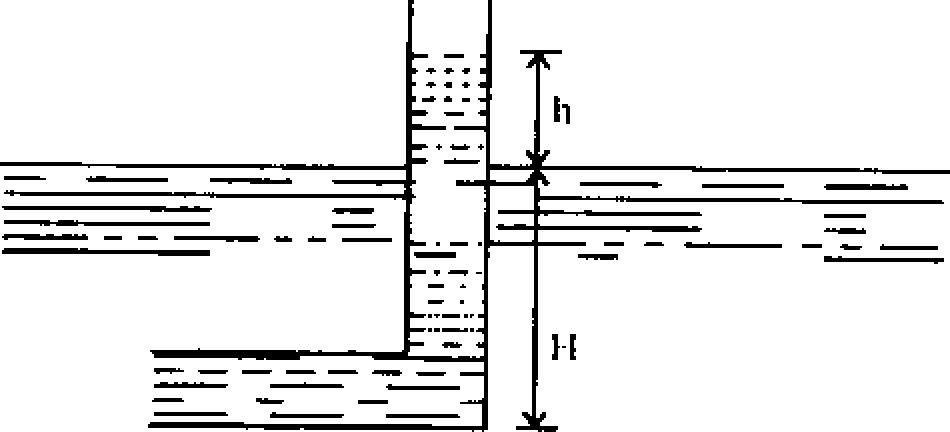
Ans. (b) Orificemeter- It is a device used for measuring the rate of flow of a fluid through a pipe. It is a cheaper device as compared to venturimeter. It also works on the same principle as that of the venturimeter. It consists of a flat circular plate which has a circular sharp edged hole callcd orifice, which is concentric with the pipe. The orifice diameter is kept generally 0.5 times the diameter of the pipe, though it may vary from 0.4 to 0.8 times the pipe diameter. 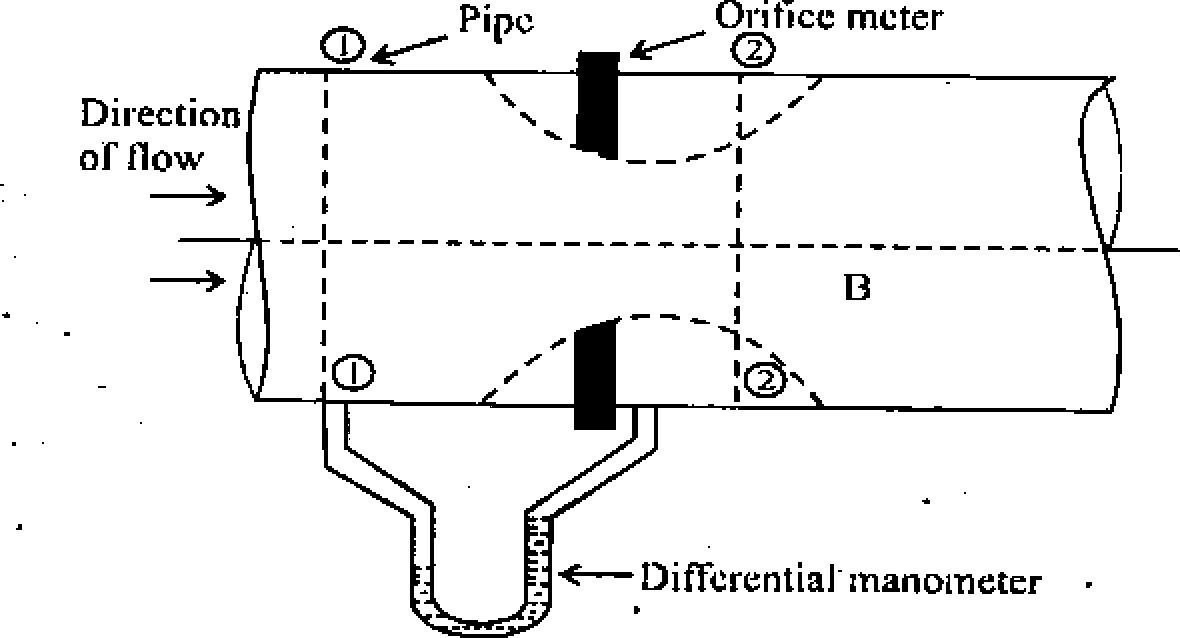
Ans. (c) Path function is that is which a process depends on the path followed. Heat and work are path functions Point function is that in which a process depends on the end states. Temperature, pressure are point functions.
Ans. <d) Streamline at any instant can be defined as an imaginaiy curve or line in the flow field so that the tangent to the curve at any point represents the direction of the instantaneous velocity at that point.
Streakline In experimental work, a die or some other indicator is of ten injected into the flow and the resulting stream of colour is known as a streakline. It gives an instantaneous picture of the positious of aH particles which have passed through the point of injection.
Pathline-An individual particle of fluid does not necessarily follow a streamline but traces out a path line. In distinction to a streamline, a pathline is not an instantaneous photograph but a time exposure showing the direction taken by the same particle at successive instant of time.
1
P + dsjdA
Add comment
| Earning: Approval pending. |
|
|
You are here:
PAPER  West Bengal Institute of Technology (WBIT) 2008-2nd Sem B.Tech Computer Science and Engineering Computer Science - Thermodynamics & Fluid Mechanics(solved) - Question Paper West Bengal Institute of Technology (WBIT) 2008-2nd Sem B.Tech Computer Science and Engineering Computer Science - Thermodynamics & Fluid Mechanics(solved) - Question Paper
| |





